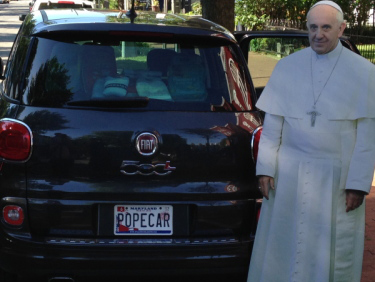CATHOLIC MATTERS
The Franciscan Stall
January 1, 2021
Since 2013 Catholic pundit after Catholic pundit has become disillusioned with Pope Francis. While their authors don't express any overt longing, at least two books looking ahead to the next pope have recently been published.
One holdout, and author of one of the next-pope books, has been my fellow-parishioner, Dr. George Weigel. Throughout Francis' scoldings of faithful Catholics, the off-the-cuff and homiletic noise leaking from his mouth, his putting his name on encyclicals that could have been written by U.N. cookie-pushers, his selling out of Chinese Catholics, his aiding and abetting of the McCarrick Gang and Italian organized crime in the Vatican, Dr. Weigel has reminded his readers more than once of Jorge Bergoglio's leadership of a 2007 synod in Apparecida, Brazil and of the future pope's role in authoring that synod's final report.
Weigel, in his 2019 book, The Irony of Modern Catholic History Etc. (1) describes the Apparecida Document as "as vibrant an expression of evangelical Catholicism as had been written in the wake of John Paul II's summons to the New Evangelization."(2) The renowned scholar further took Francis' first encyclical Evengelii Gaudium as further proof of the pontiff's continuance of the St. John Paul II/Benedict XVI ("JPII/BXVI") project of engaging the modern world with a Christ-centered Evangelical Catholicism.
That is why it was a surprise, in reading near the conclusion of The Irony of Modern Catholic History Etc., to run across the subhead, "The Franciscan Stall." Turning the page to this made for a pleasant and unexpected encounter, like turning a corner and running into a pretty lady friend wearing her Ginger Rogers tilt hat and an "I vote Pro-Life" button.
In "The Franciscan Stall," Dr. Weigel eyes two major obstacles that Francis has allowed to be plopped in front of JPII/BXVI's pathway for the church in the Third Millennium: 1) the insertion in Francis' Apostolic Exhortation, Amoris Laetitia, of dissenting Catholics' opinion that human experience and understanding have moved on since Jesus' and St. Paul's teaching, respectively, on marriage and receiving the eucharist; thus the church no longer has to follow Jesus or Paul; 2) the view that Catholic church is a federation of national synods (say, that of Germany) wherein each national synod can make up its own rules, thus resulting in "a Catholicism in what [is] deemed true in Poland [is] not deemed true in Germany."(3).
Dr. Weigel does not mention other Franciscan distractions and vandalisms: the tedious revisiting of the settled issues of married priests and the ordination of women; the obsession with climate change; the gutting of St. John Paul II's Institute For Marriage And Family Studies.
But is Pope Francis and the mess he has made really sole cause of the stall?
Mutter, mutter, mill, mill
Looking back to the year 2000, it seems to me that the great reforms begun late in the last century started lagging before Bergoglio's election in 2013. We were charging across a field bearing the banners of Fides et Ratio, Theology of The Body, The Institute For Marriage And Family Studies, numerous other initiatives. Then this heavily-armed wave of inspired Catholic humanity slowed. Then it stopped. Then the troops just stood there, milling and muttering. About what: Joy.
The papacies of St. John Paul II and Benedict XVI, as Dr. Weigel wrote, should be understood as a "continuous 35-year-long effort..." (4). Both men's pontificates were about action, reform, teaching, augmenting the wisdom of the church for the years beginning with "2."
The charismatic John Paul II traveled the world, inspiring what is now known as "the John Paul II generation." He published 14 encyclicals and issued apostolic constitutions such as Ex Corde Ecclesiae (regarding Catholic universities). He oversaw the promulgation of the first catechism since 1566. He expounded his Theology of The Body which in God's good time, will restore sanity and morality to attitudes about sex in the world. He reformed seminaries which is why most abuse cases in the news today are not recent, but decades old. He inspired new Catholic schools -- likely more than the market can handle -- faithful to Catholic identity and teaching.
The saint's Institute For Marriage And Family Studies was wrecked under Francis, but not before its worldwide branches dispatched thousands of young men and women, including priests and religious, carrying John Paul II's teachings for the Third Millenium.
The likely-reluctant pontiff Benedict, too shy, too modern-priestly and perhaps too ill to take on the McCarrick and Italian gangs, delivered lectures and wrote the Jesus of Nazareth trilogy. Every Catholic should read at least a couple of Benedict's surprisefully accessible works.
The man who should be the next pope, Cardinal Robert Sarah, declared that Benedict, post-abdication, is an "...extraordinary beacon....He is at the head of the great cohort of contemplatives who mysteriously carry the world. The pope emeritus contrasts contemplation and prayer with petty earthly ambitions. Humbly, he bears witness to the divine absolute." (5)
Also by Neal J. Conway:
In the Nihil-Obstat-bestowed volume of private revelation, In Sinu Jesu (6), written several years before Cardinal Sarah's assessment, Jesus mentions Benedict a few times, telling the anonymous Benedictine monk "Listen well to all [Benedict's] teachings. Receive them and make them known, for he is My messenger and My victim-priest in the midst of a world that closes its ears to My word and that still derides the mystery of the cross."(7)
Focusing on evangelization and the heart (core) of the church, Saint John Paul and future saint Benedict's papacies were about prayer and work, including study. They were about ora et labora, "uniting work with prayer...in the development of The Kingdom of God," as JPII wrote in Laborem Exercens V, 27 (8).
Yes, it seems to me that this new springtime, this growth faded some time during Benedict's papacy. My opinion is that it stalled because despite the efforts of both popes, the Catholic church is still a disordered church that puts relationships first, before all else, including right and truth, including core beliefs, including achievement, including standards, including even mission.
If Catholics are frustrated that priests never preach the hard truths about abortion or the Real Presence being the center of our faith, it is because of this culture of putting relationships first. The church cherishes relationships and unity so inordinately it will compromise to establish them or avoid giving offense that may end them.
Some call this "The Church of Nice." A few call it a "feminized church" (9) because a natural female tendency is to put relationships first.
The problem with chronically putting relationships before commandments and standards is that eventually, the commandments and standards cease to matter at all.


